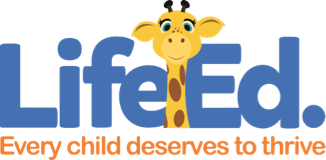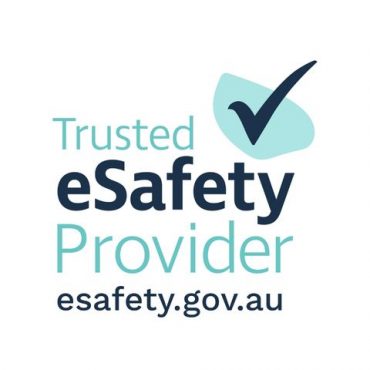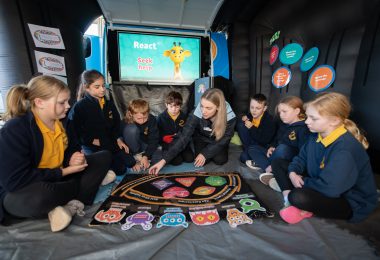bCyberwise
For Years 3 - 5
Harold loves going online to connect with his friends and family. Join Harold as he learns how to use the internet safely and respectfully.
Overview
This up-to-date module explores a range of contemporary issues including recognising the body clues that warn us about unsafe or potential predatory behaviours and learning how to react to risks and report problems online. Online privacy and respectful relationships are also covered.
Life Ed are proud to be endorsed by the eSafety Commissioner as a Trusted eSafety Provider for our online safety program, bCyberwise. The Trusted eSafety Provider program helps you take the guesswork out of identifying a great online safety education provider for your school. Trusted eSafety Providers are endorsed after demonstrating that they meet eSafety’s requirements for online safety education, including:
• suitable expertise and experience
• evidence-based and curriculum-aligned programs
• compliance with appropriate child safety and insurance requirements.
Life Ed programs are not just a visit, they’re a 4 - step student pathway! So make use of the whole multimodal pathway… the pre visit lesson; the Life Ed Educator visit; the 2 post visit lessons, the booster lessons and the parent communication.
The key learning areas covered include:
Life Ed are proud to be endorsed by the eSafety Commissioner as a Trusted eSafety Provider for our online safety program, bCyberwise. The Trusted eSafety Provider program helps you take the guesswork out of identifying a great online safety education provider for your school. Trusted eSafety Providers are endorsed after demonstrating that they meet eSafety’s requirements for online safety education, including:
• suitable expertise and experience
• evidence-based and curriculum-aligned programs
• compliance with appropriate child safety and insurance requirements.
Life Ed programs are not just a visit, they’re a 4 - step student pathway! So make use of the whole multimodal pathway… the pre visit lesson; the Life Ed Educator visit; the 2 post visit lessons, the booster lessons and the parent communication.
The key learning areas covered include:
- How to recognise, react and report unwanted contact, bullying or predatory behaviours.
- Keeping personal information safe online.
- Responsible and respectful behaviour when using communication technology.
- Skills for building positive relationships with friends.
- Exploring the role of bystanders.
Step 1: Pre-lesson
To be completed with your class before the Life Ed visit.
bCyberwise – Pre Visit Lesson – Tech
Before Healthy Harold’s visit, try this interactive lesson with your class. These activities maximise student voice and participation in the upcoming Life Ed Visit.
Students consider the technology that is all around us and how we use it for many different tasks throughout the day. They take a closer look at their own personal use of technology on a daily basis.
Activities include • stories • tech checks • class discussions • think, pair, share • role plays
25 - 30 minutes - Depending on duration of discussion
School Lesson
Pre lesson – An Overview for Parents
Step 2: Life Ed Visit
This is the core part of the program. If you have booked a visit with Life Ed, this will be delivered in the Mobile Learning Centre or in your classroom by a specialist Life Ed Educator.
Step 3: Post Visit
To be completed with your class after the Life Ed visit.
bCyberwise – Extending Lesson 1 – Photo Talk
This lesson delves further into Cybersafety, the do's and don’ts of sharing photos online and protecting their own & others’ privacy. Students are empowered to know when things are not okay online and to develop personal rules about posting. The difference between jokes and bullying is addressed.
Activities include • group work • sample scenarios • sorting • class discussions • video • at home follow up
25 - 30 minutes - Depending on duration of discussion
School Lesson
bCyberwise – Extending Lesson 2 – Cyberbullying
Through a variety of activities students develop tools, strategies and places to seek help in managing cyberbullying. They’re also empowered with knowledge to avoid ambiguity in their own posts and reminded to stay positive online.
Activities include • voting • think, pair, share • videos • brainstorming • personal reflection • parent interviews
25 - 30 minutes - Depending on duration of discussion
School Lesson
Attention: Teachers
Use this Assessment Rubric (PDF) to assist with assessing the student comprehension of bCyberwise Booster Session content.
Step 4: Booster Sessions
The Booster sessions videos and discussion guides are the last part in the 4-Step program. A discussion guide with questions and suggested answers is attached with each booster session video below. To meet all of the outcomes for this module, teachers are encouraged to use the discussion guides to extend student learning and observe student understanding of the content covered.
bCyberwise – Session 1 – Personal Safety Online
Harold’s on a quest to understand the online world. Kids talk about some of the ways they like to use the internet, and some of their experiences online, good and bad. Harold helps students understand ways to stay safe online including safe passwords, safe profile pictures and respectful posting.
25 - 30 minutes - Depending on duration of discussion
Video Lesson
Assessment Task (PDF)
Discussion Guide (PDF)
bCyberwise – Session 2 – Positive Interactions Online
Harold uses the internet to keep in touch with family and friends across the world. Students are given guidance about age-appropriate apps, and when to accept friend requests. The concept of body clues or warning signs to unsafe or dangerous behaviour is partnered with exploring who is in a student's safety network of adults they trust.
25 - 30 minutes - Depending on duration of discussion
Video Lesson
Assessment Task (PDF)
Discussion Guide (PDF)
bCyberwise – Session 3 – Strategies to Stay Safe
Harold’s increasing popularity online leads him to behave a bit smugly. Students consider ways to stay safe online including connecting only with known people, having strong passwords, and respecting people’s privacy by asking consent to share photos or videos of them. Students learn to recognise, react, and report when they are feeling unsafe online.
25 - 30 minutes - Depending on duration of discussion
Video Lesson
Assessment Task (PDF)
Discussion Guide (PDF)











